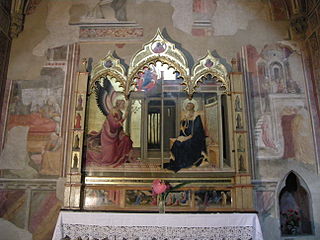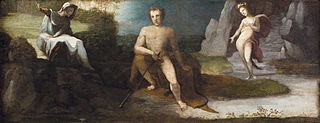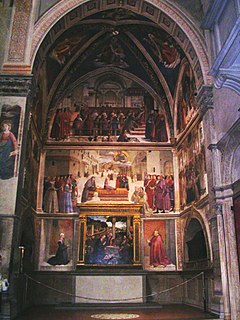 W
WThe Adoration of the Magi is a painting by the Italian Renaissance master Domenico Ghirlandaio, executed around 1485-1488 and housed in the Ospedale degli Innocenti gallery in Florence, Italy. The predella, painted by Bartolomeo di Giovanni, is in the same site.
 W
WThe Baroncelli Chapel is a chapel located at the end of the right transept in church of Santa Croce, central Florence, Italy.
 W
WThe Bartolini Salimbeni Annunciation is a painting by the Italian Gothic painter Lorenzo Monaco, completed just before his death (1420–1424) and housed in the Bartolini Salimbeni Chapel of the church of Santa Trinita, Florence, Italy.
 W
WThe Boldrone Shrine is located at the corner of the Via di Boldrone and the Via dell'Osservatorio in the Quarto district of Florence. It was named after the monastery of San Giovanni Evangelista di Boldrone, which was itself named after the French "Boldrone" hermitage founded on that site in the 13th century.
 W
WThe Choice of Hercules or Hercules at the Crossroads is a c.1520-1525 oil on canvas painting by Domenico Beccafumi, now in the Museo Bardini in Florence. It is strongly influenced by Baldassarre Peruzzi's frieze at the Villa Farnesina, placing it after Beccafumi's possible trip to Rome around 1512.
 W
WThe Crossing of the Red Sea, also known as The Crossing of the Red Sea and Moses Appointing Joshua, is a fresco painting by the Italian artist Agnolo di Cosimo, known as Bronzino, finished in 1542. It is housed in the Palazzo Vecchio, Florence. In 1540, Cosimo I de' Medici and/or his wife, Eleanor of Toledo, commissioned this and other frescoes for Eleanor's private chapel. Three of the four walls of the small chapel found on the second floor of the palace are covered with works telling the story of Moses.
 W
WThe Crucifix by Cimabue at Santa Croce is a wooden crucifix, painted in distemper, attributed to the Florentine painter and mosaicist Cimabue, one of two large crucifixes attributed to him. The work was commissioned by the Franciscan friars of Santa Croce and is built from a complex arrangement of five main and eight ancillary timber boards. It is one of the first Italian artworks to break from the late medieval Byzantine style and is renowned for its technical innovations and humanistic iconography.
 W
WThe Holy Trinity, with the Virgin and Saint John and donors is a fresco by the Early Italian Renaissance painter Masaccio. It is located in the Dominican church of Santa Maria Novella, in Florence.
 W
WThe Infant Saint John the Baptist is a c.1521 oil on panel painting by Rosso Fiorentino, now in a private collection in Florence. Stylistically close to the artist's Volterra Deposition, its nervy contour lines and gaunt brushstrokes are also similar to his Holy Family with the Infant Saint John the Baptist.
 W
WThe Intercession Altarpiece is a five-panel tempera and gold on panel painting by Gentile da Fabriano, produced during his stay in Florence from 1420 to 1423. Its original location is unknown, though it is now in the sacristy of San Niccolò sopr'Arno in Florence. It is named after its central panel of Jesus and the Virgin Mary interceding to God the Father. The two outermost panels show Louis of Toulouse and Bernard of Clairvaux. The two inner side-panels show the Resurrection of Lazarus and a group of three saints '
 W
WThe Last Supper (1445–1450) is a fresco by the Italian Renaissance artist Andrea del Castagno, located in the refectory of the convent of Sant'Apollonia, now the Museo di Cenacolo di Sant'Apollonia, and accessed through a door on Via Ventisette Aprile at the corner with Santa Reparata, in Florence, region of Tuscany. The painting depicts Jesus and the Apostles during the Last Supper, with Judas, unlike all the other apostles, sitting separately on the near side of the table, as is common in depictions of the Last Supper in Christian art.
 W
WThe Last Supper (1480) is a fresco depicting the Last Supper of Jesus by the Italian Renaissance artist Domenico Ghirlandaio; it is located in the refectory of the Convent of the Ognissanti on Borgo Ognissanti #42 in central Florence, region of Tuscany, Italy. It is one of three Last Supper frescoes painted by Ghirlandaio in Florence, the others being for the Badia di Passignano (1476) and for the Cenacolo di San Marco (1486).
 W
WMadonna and Child with Two Saints is a c.1492-1493 tempera on panel tondo painting by Luca Signorelli, 112 cm in diameter. It is in the Galleria Corsini of the Palazzo Corsini in Florence, whilst a larger autograph replica known as the Baduel Tondo (c.1492-1500) is now in the Museo Bandini in Fiesole. To the left is Saint Jerome whilst to the right is Bernard of Clairvaux.
 W
WThe Magi Chapel is a chapel in the Palazzo Medici Riccardi of Florence, Italy. Its walls are almost entirely covered by a famous cycle of frescoes by the Renaissance master Benozzo Gozzoli, painted around 1459 for the Medici family, the effective rulers of Florence.
 W
WMarriage of the Virgin or the Ginori Altarpiece is a 1523 oil on panel painting by Rosso Fiorentino, signed and dated by the artist. It was commissioned by Carlo Ginori for the chapel dedicated to the Virgin Mary and saint Joseph - previously owned by the Masi family that chapel had been acquired by the Ginori family in 1520. It still hangs in the Basilica, whilst a drawn copy attributed to Antonio Circignani is now in the Louvre (n.1592).
 W
WSaint Jerome in His Study is a fresco by the Italian Renaissance painter Domenico Ghirlandaio, executed in 1480 and located in the church of Ognissanti, Florence.
 W
WThe Sassetti Chapel is a chapel in the basilica of Santa Trinita in Florence, Italy. It is especially notable for its frescoes of the Stories of St. Francis, considered Domenico Ghirlandaio's masterwork.
 W
WThe Studiolo is a small painting-encrusted barrel-vaulted room in the Palazzo Vecchio, Florence. It was commissioned by Francesco I de' Medici, Grand Duke of Tuscany. It was completed for the duke from 1570-1572, by teams of artists under the supervision of Giorgio Vasari and the scholars Giovanni Batista Adriani and Vincenzo Borghini.
 W
WThe Tornabuoni Chapel is the main chapel in the church of Santa Maria Novella, Florence, Italy. It is famous for the extensive and well-preserved fresco cycle on its walls, one of the most complete in the city, which was created by Domenico Ghirlandaio and his workshop between 1485 and 1490.